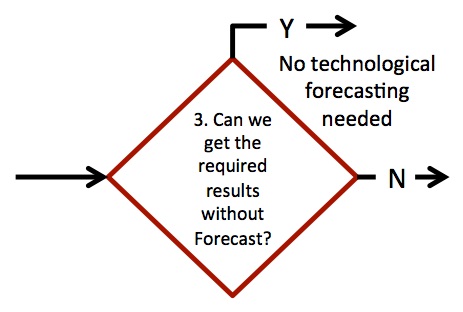This is a decision step that differentiates forecasting and problem solving activities for formulated objectives.
Method Method = FORMAT methodology
In this step the key question has to be answered:
Can we get the required results without Forecast?
Restating the above question: Can we satisfy the formulated needs (Step 1: Why? + Step 2: What?) without Technological Forecast? (Yes/No)
A decision has to be made at this step whether to proceed with the project as a technology forecasting project OR to switch to a problem solving task.
Instructions
- Review results of Step 1 of Stage FOR and Step 2 of Stage FOR for logical consistency.
- Discuss these questions:
- How can the main objectives be satisfied if there was no forecast? For example, by strategic planning, by problem solving or by quality assessment.
- The following question needs to be answered with a clear yes or a no: Can the formulated needs (Step 1: Why? + Step 2: What?) be satisfied without technological forecast?
Tips
➔ The decision should be made with the participation of beneficiaries and users.
➔ Be aware of the following situation: the main objective may seem to be a candidate for technology forecasting, but after preliminary investigation of Step 1 and Step 2 of the FOR stage, it may turn out to be “just” a request to solve a specific problem that does not require a forecast about the future.
Suggested reading
Kaikov, I. (2013). Method of Selection of Test Cases for FORMAT. [Online] Available: http://www.format-project.eu/deliverables/white-papers/december-2013-method-of-selection-of-test-cases-for-format/at_download/file
Example
Example 1. Super-Capacitor (for more detailed information, please see previous steps)
Step 3: Can we get the required results without Forecast?
Do we really need to forecast the future to answer that question or is it sufficient to address the problem with a problem solving approach?
Decision: we cannot get the required results without a forecast, hence proceed to Step 4.
Example 2. Gas leak checks in refrigerator (for more detailed information, please see previous steps)
Step 3: Can we get the required results without Forecast?
Do we really need to forecast the future to answer that question or is it sufficient to address the problem with a problem solving approach?
Yes, we can. We need not forecast the future if we can solve the problem “How to connect all parts in a sealed system assembly?”
Decision: Start a project for problem solving.
Example 3. Flying car (for more detailed information, please see previous steps)
Step 3: Can we get the required results without Forecast?
Do we really need to forecast the future to answer that question or is it sufficient to address the problem with a problem solving approach?
Decision: we cannot get the required results without a forecast, hence proceed to Step 4.
v2



